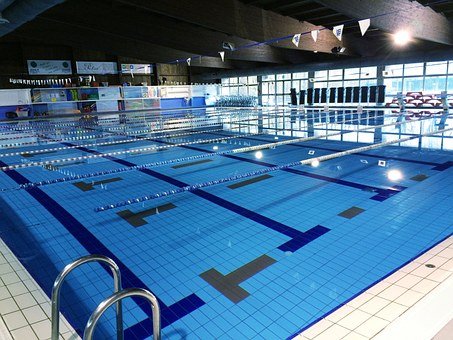
Water is the one of the essential elements we can find in our planet. Training in water can be a very important resource for sport people from the every level and age. There are many ways, motivations and strategies to use the work in water: surgery, disability, muscle and joint recovery, muscular strengthening. In different times I used the swimming pool to differentiate the stimulus to my athletes, which appreciating the utility and having back from them positive feedback.
The scientific research is getting more and more focused on articles and studies about the benefits of water to the rehabilitative, wellness and performance sides.
A very close friend of mine, a professional of Sport Science and specialized in this topic, is gonna describing the qualities, the characteristics and potentials of water, basing on his formation and large experience.
With big pleasure, I publish “Functional H2O”, by Andrea Fiorin.
Functional H2O
Premise
Over the past few years, where everything is functional and highly specialized, leading to excess, it is worthwhile to revise and put in order the principles and means that characterize the training methodology. In the world of wellness and performance, as well as the course of psycho – physical wellbeing or preparation, we can include also the water: natural element that must be considered as one of the training elements. But in which way the training in water is functional? Is it just an analgesic therapy? Why tapering in water can be preferred therapy instead of easier dry land training? In order to find the answers to those questions let’s start with the knowledge of water environment and the possibilities that can provide specialists both physical therapist and physical trainer.
The physical quality of water has a positive impact on musculoskeletal, cardiovascular, nervous and respiratory systems. It benefits to recharge, reabsorptions of potential edema, relaxation as well as muscular activation and resistance opposite to body movements.
Water is often used for the purpose of rehabilitation kinesiology but based on the amount of water that is used for body immerse and exercise intensity, water can be used also as physical training of a more general nature. Obviously it is not a sport specific type of physical preparation, except in the case of water sport.
In which case the work program in water is advised? Water in a specific way is recommended in the early stages of all recovery programs after surgical operations, trauma or injuries, conservative treatments, correct recovery due to spontaneous or sport movements. The training in water can be linked also to a dry work protocol or used as a unique program; in this case it is required to perform exercises in total or partial discharge, in order to perform movements that would be impossible or nearly impossible to realize out of the water – in the environment conditioned by gravity. In water, depending on the problem to be treated and the ongoing phase, the movement performed by a subject can be active assisted or totally active. Voluntary movement is a conscious activity, a result of neuromuscular coordination, realized to recover actively the defective motor skills. Actively assisted movement provides manual support (movements led by the healthy limb in the exercises for the shoulders), instrumental (pulley, 1% stick, floating) or for hydrostatic push (with or without floating). This type of movement is used mostly at early stage where the priority is mobilization in discharge (mobilization in unloading) or joint recovery with pain control as well as in warm up. Instead totally active moments expect the performance of voluntary muscular contractions with a goal to maintain ROM, recover strength and resistance, neuro-muscular coordination and proprioceptive sensibility.
Physical principles of water:
- Floating hydrostatic push
- Hydrostatic pressure
- Viscosity (or hydrodynamic resistance)
- Temperature
- Depth
Archimedes’ principle states that the upward buoyant force that is exerted on a body immersed in a fluid, whether fully or partially submerged, is equal to the weight of the fluid that the body displaces and acts in the upward direction at the center of mass of the displaced fluid. Thus, if immersed in water up to the belly button, the weight will be reduced by about 50%, and up to 90% if immersed up to the neck.
This floating hydrostatic push in antigravity environment allows the movements precociously regain rehabilitation (de-ambulation), lightening the weight on the compromised joints and improving the spraying of the cartilaginous tissue.
The pressure of the body immersed in the liquid is directly proportional to the specific weight of the liquid and to the depth at which the body is situated. This hydrostatic pressure is exerted perpendicularly at each point of the body surface, improving balance and proprioception; by increasing the depth it has an impact on the circulatory system, in particular on the venous circulation, and on the lymphatic one, thus favoring the re-absorption of edema and swelling. Besides a peripheral vasoconstriction at the level of the immersed limbs, it stimulates and influences the expansion of the rib cage. The resistance that water opposes to the movement of the body moving inside it is determined by the viscosity of the liquid itself. This physical propriety allows muscle strengthening and is proportional to the speed of movement: if doubling the speed of the movement, the resistance increases four times. The resistance effect, which is sought to increase the workload, is also accentuated by the use of tools that increase the immersed surface. Also a turbulent flow increases the friction between the molecules of the liquid and, consequently, resistance to the movement.
As for the temperature, the water of modern re-educational tubs is maintained at around 32/33 degrees Celsius, to make the most of the properties of vasodilation of heat, which increases vascularization and therefore oxygenation of tissues, with muscle relaxant and analgesic effect.
It should be borne in mind that too hot water leads to early muscle fatigue, while, on the contrary, too cold water leads to an increase in muscle tone and promotes involuntary muscle contractions.
It comes naturally to think that when you want to perform prolonged aerobic exercise or medium high intensity aerobic exercise, it is advisable to have a water temperature around 28 degrees Celsius.
Depending on the purpose of the program, re-educational and/or rehabilitative, re-athleticism or conditioning, water depth is a determining factor because the water level changes the hydrostatic pressure and the load that weighs on the human body.
LOW WATER: 60-80 cm (up to the thigh)
HIGH WATER: 120-140 cm (up to the abdomen)
DEEP WATER: >180cm (up to the neck without touching the bottom of the pool)
|
WATER LEVEL |
WATER RELATED WEIGHT |
| TOTAL IMMERSION | 3% of the terrestrial weight |
| UP TO THE NECK | 7% |
| UP TO THE SHOULDERS | 20% |
| UP TO THE CHEST | 33% |
| UP TO THE BELLY BUTTON | 50% |
| UP TO THE HIPS | 66% |
| UP TO THE HALF THIGH | 80% |
| UP TO THE CALF | 95% |
Below are the basic principles for writing water working protocols:
Hydrotherapy: practical examples
From the basic concepts learned, we now develop, through some practical examples, a proper progression of exercises useful for re-educational therapy in water. Specifically we will cover the post-shoulder injury re-educational cycle.
The re-educational or water work cycle is often divided into three phases: each stage is obviously subject to possible changes depending on the characteristics of the person and the issues to be addressed (tendinopathy, capsulitis, injury of other nature, type of surgery, etc.), at its level of coordination and familiarity with the aquatic environment, and the goals to be achieved, be it a sedentary, a sportsman or a competitive athlete.
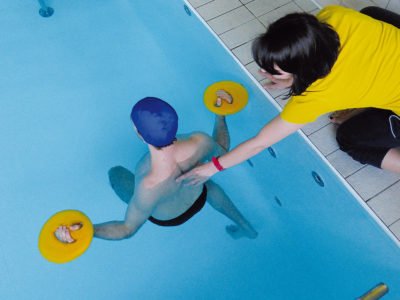
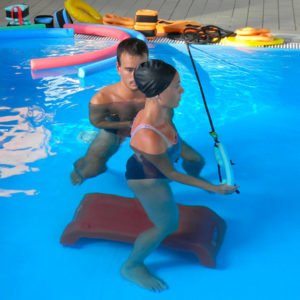
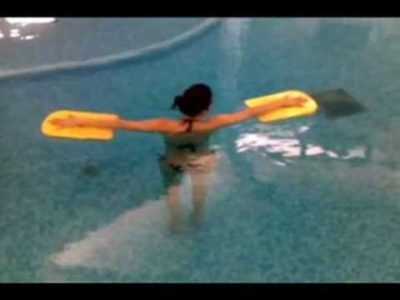
Keep in mind that behind every trauma or intervention there is a subject that reacts and organizes itself differently from another, and it is preferable to talk about individualized guidelines. It is also true that a competitive athlete has different needs and specific sports also in the correct approach and in the most effective proposal in pool. The images above are part of an exercise protocol for shoulder girdle: at this stage, before proposing specific exercises or with equipment and operate in an analytical manner, you need to set the organism in motion with a general activation, even with the lower limbs, useful to activate aerobic metabolism that can help in order to dispose of catabolytes and slag dates of the inflammation in place.
Specific activation is done through flexibility exercises on all floors, in the degrees of movement allowed and possibly active-assisted by the other limb. To “attend” range of movement over 60 degrees of abduction or over 90 degrees of flexion of the arm on the sagittal plane is possible with the use of floats (belts, roundabouts, etc.) make movements in the prone position called prono buoyancy commuter exercises.
In addition to many tools that can help you carry out proprioceptive and control exercises, or exercises of pure muscle “awakening”, such as chopsticks, tablet, roundludo, water bars, etc., there is the possibility to use the edge of the tub or on some occasions, if it is equipped, a stool, closed kinetic chain exercises.
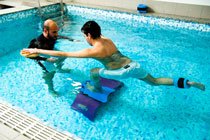
Classification of stimulus by duration
Mobility, Stability and Strength: even in the aquatic environment it is important to follow this progression, and you can orient yourself through the proposal of exercises and the duration of the proposed stimulus. At an early stage, it is a good practice to perform exercises with a movement arc leading to the pain threshold, and where” favorable” conditions persist (motivated subject, with positive attitude) could be useful try to overcome the limit imposed by the pain itself. We talked about the threshold for the simple reason that pain must still be kept under control. It represents a significant factor, as, if not tolerated, it alters functions and inhibits muscle activities.
In this first phase the proposal will be limited and quantized in a few exercises and high number of repetitions to be able to check the quality of movements: 5/6 exercises 1/2 series 20/30 repetition.
In stability and proprioception exercises, the proposal is subject-dependent: when the quality expires, the proposal must be changed and reformulated. The proposed exercises must be 2/3 from 1 series of 15/20 repetitions.
In the subsequent re-educational phase, muscle strengthening exercises are equally important, significantly engaging the subject and the affected joint.
For this reason it is considered useful for proper programming of muscle-strengthening sessions, strength exercises with flexibility exercises and active stretching called complementary or compensation exercises.
In this last phase, increasingly, the subject will begin to perform 1 exercise of strength of 10 repetitions and 1 complementary exercise, up to 5 strength exercises (different from each other, in terms of proposed movements) and 1 complementary exercise. In a second step, the proposal will increase the volume of work by proposing strength exercises from 20 repetitions on different planes and axes to be alternated with active recovery exercises.
A station route, or circuit training, could be another useful method in order to better organize a work in the water, even in pairs or in groups.
Andrea Fiorin
Strength and conditioning coach Venezia FC
Fitness consultant
Bibliography
RIABILITAZIONE IN ACQUA Broglio – Colucci, Colucci, Edi-ermes.
PREPARAZIONE FISICA IN ACQUA Master Training, Piero Pigliapoco, Piero Benelli.
IN ACQUA PER IL CUORE Autori vari, Sport & Medicina, luglio – settembre 2017.
IN ACQUA Umberto Borino, Stefano Di Coscio, Edizioni Correre 2011.
WATSU – LA CURA E LA LIBERTA` DELL`ACQUA Watsu Italia, Xenia 2016.
FITNESS IN ACQUA FIN Federazione Italiana Nuoto, Settore Istruzione Tecnica
CONI
Leave a Reply